Abstract
The suppression of immune responsiveness to heterologous antigenic stimulation during concurrent infection with Nematospiroides dubius was reproduced using soluble antigens derived from adult parasites. Immunosuppression appeared to be selective in that the administration of equivalent quantities of an irrelevant heterogeneous antigen had no immunosuppressive effect, and suppression was transferable using spleen cells from parasite antigen-treated donors. The differential immunomodulatory activity of parasite antigens from a variety of nematode species suggested that a correlation might exist between suppressor activity and chronicity of infection. A role for suppressor T cell activity in the infected host was implicated by the restorative effect of 2'deoxyguanosine treatment on the immune response, and non-specific suppressor cell activity was detected in splenocyte populations from infected mice. It is suggested that a parasite-induced defect in antigen processing led to the induction of suppressor cell activity in the infected host and that this may be one mechanism of parasite survival. The relevance of these observations to vaccination against chronic gastrointestinal nematode infections is discussed.
Full text
PDF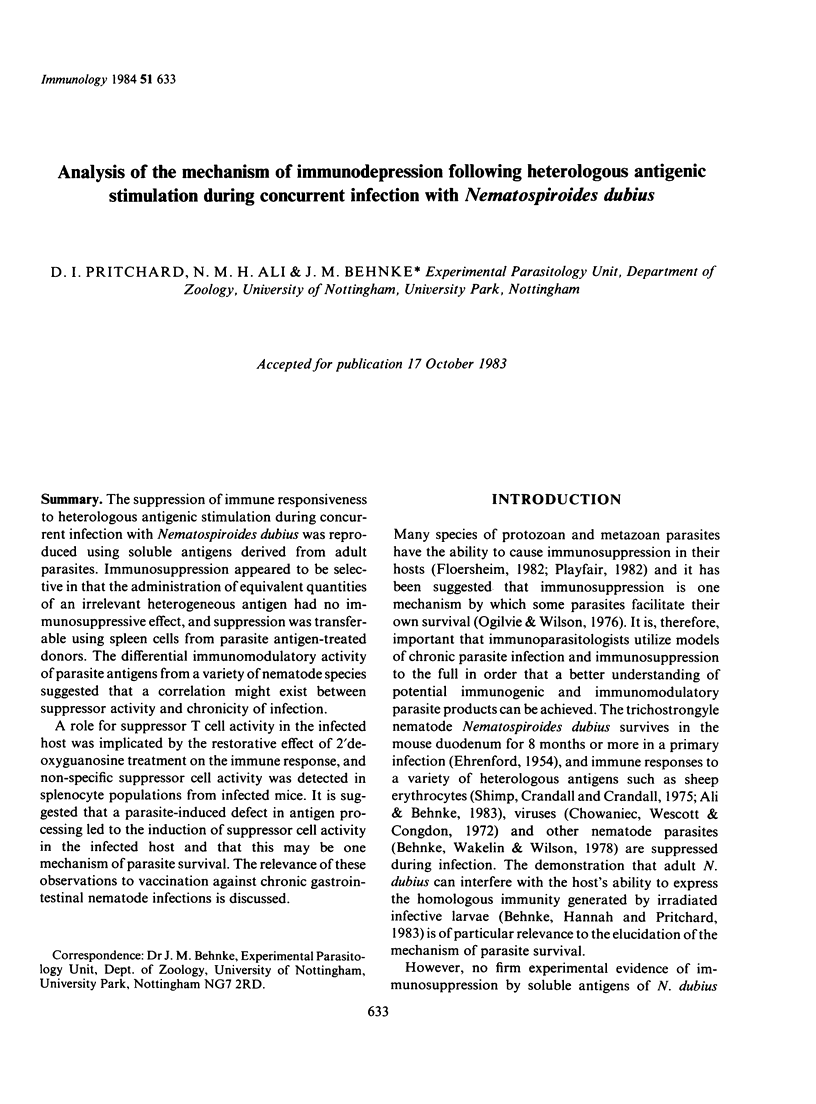

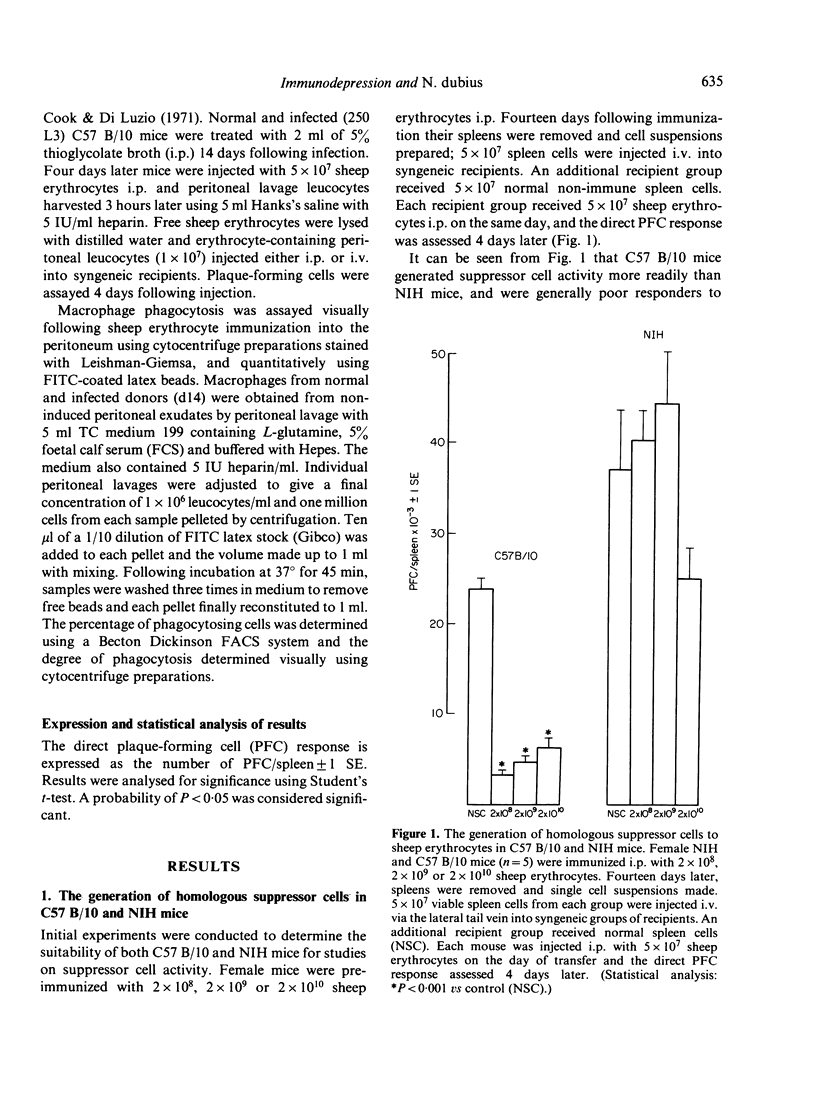
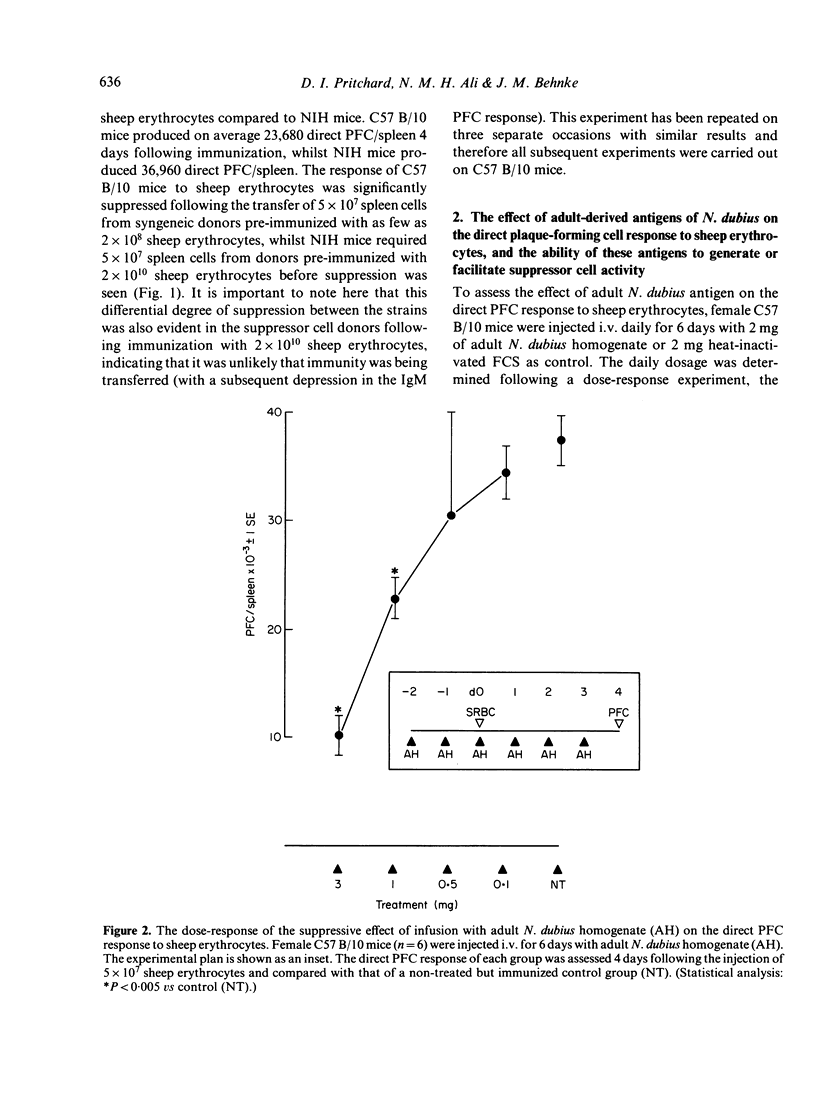

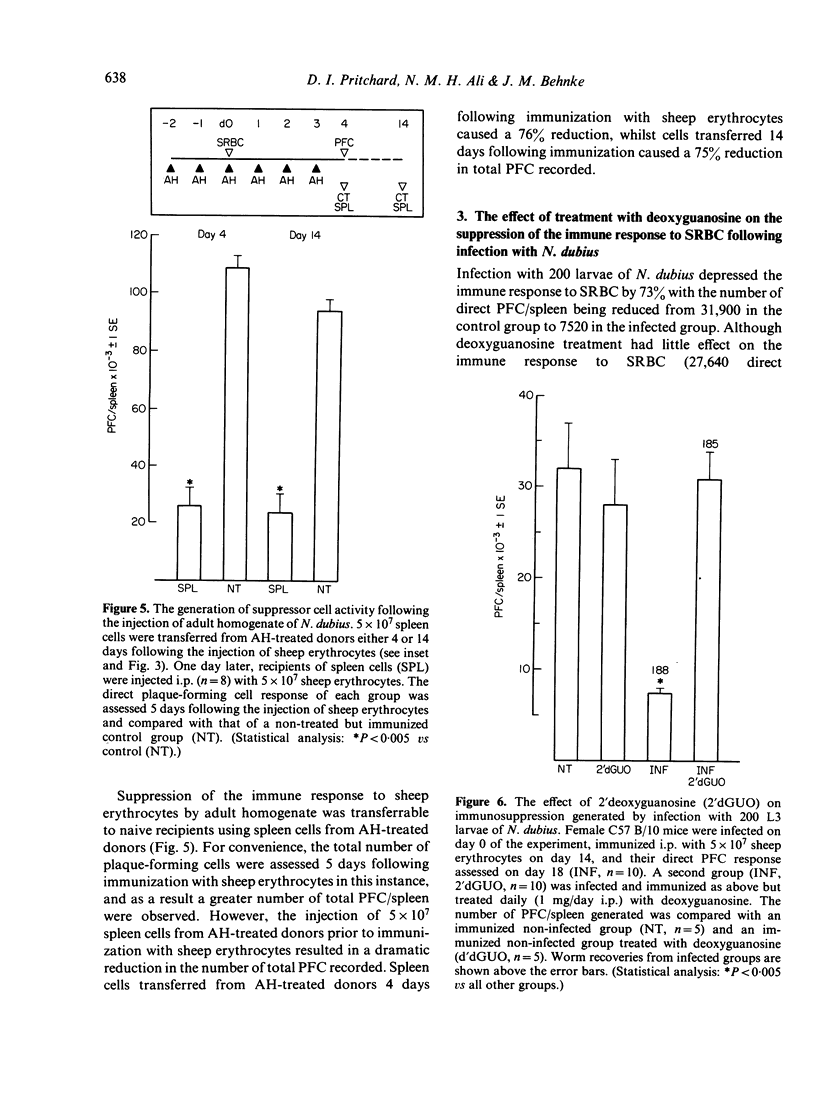
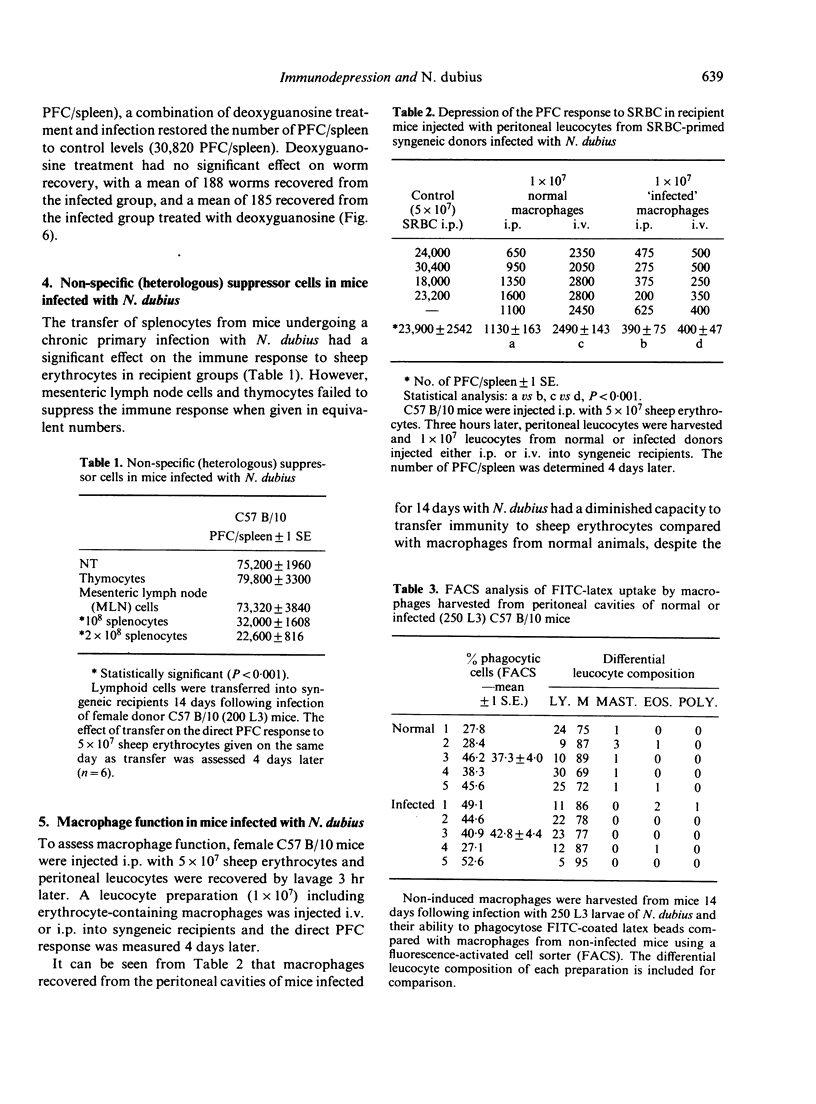


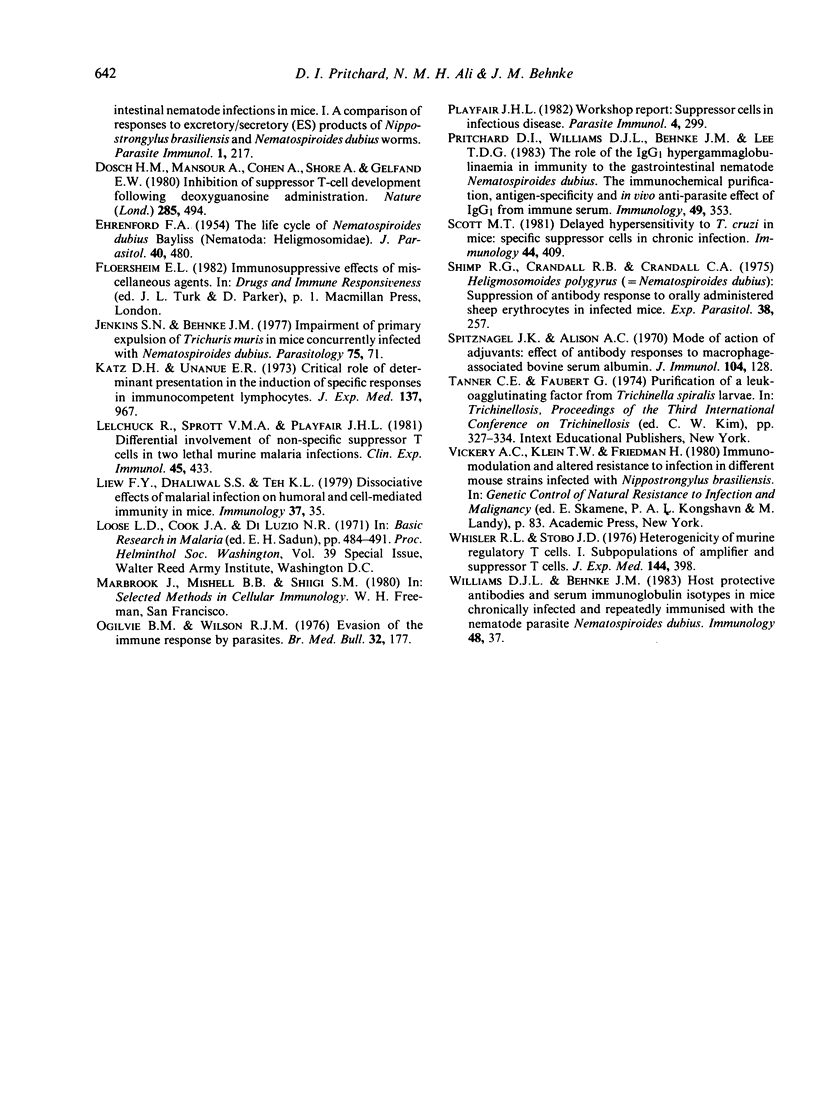
Selected References
These references are in PubMed. This may not be the complete list of references from this article.
- Ali N. M., Behnke J. M. Nematospiroides dubius: factors affecting the primary response to SRBC in infected mice. J Helminthol. 1983 Dec;57(4):343–353. doi: 10.1017/s0022149x00011068. [DOI] [PubMed] [Google Scholar]
- Behnke J. M., Hannah J., Pritchard D. I. Nematospiroides dubius in the mouse: evidence that adult worms depress the expression of homologous immunity. Parasite Immunol. 1983 Jul;5(4):397–408. doi: 10.1111/j.1365-3024.1983.tb00755.x. [DOI] [PubMed] [Google Scholar]
- Behnke J. M., Parish H. A. Expulsion of Nematospiroides dubius from the intestine of mice treated with immune serum. Parasite Immunol. 1979 Spring;1(1):13–26. doi: 10.1111/j.1365-3024.1979.tb00692.x. [DOI] [PubMed] [Google Scholar]
- Behnke J. M., Wakelin D. Nematospiroides dubius: stimulation of acquired immunity in inbred strains of mice. J Helminthol. 1977 Sep;51(3):167–176. doi: 10.1017/s0022149x0000746x. [DOI] [PubMed] [Google Scholar]
- Behnke J. M., Wakelin D., Wilson M. M. Trichinella spiralis: delayed rejection in mice concurrently infected with Nematospiroides dubius. Exp Parasitol. 1978 Nov;46(1):121–130. doi: 10.1016/0014-4894(78)90162-5. [DOI] [PubMed] [Google Scholar]
- Chowaniec W., Wescott R. B., Congdon L. L. Interaction of Nematospiroides dubius and influenza virus in mice. Exp Parasitol. 1972 Aug;32(1):33–44. doi: 10.1016/0014-4894(72)90007-0. [DOI] [PubMed] [Google Scholar]
- Cunningham A. J., Szenberg A. Further improvements in the plaque technique for detecting single antibody-forming cells. Immunology. 1968 Apr;14(4):599–600. [PMC free article] [PubMed] [Google Scholar]
- Day K. P., Howard R. J., Prowse S. J., Chapman C. B., Mitchell G. F. Studies on chronic versus transient intestinal nematode infections in mice. I. A. comparison of responses to excretory/secretory (ES) products of Nippostrongylus brasiliensis and Nematospiroides dubius worms. Parasite Immunol. 1979 Autumn;1(3):217–239. doi: 10.1111/j.1365-3024.1979.tb00708.x. [DOI] [PubMed] [Google Scholar]
- Dosch H. M., Mansour A., Cohen A., Shore A., Gelfand E. W. Inhibition of suppressor T-cell development following deoxyguanosine administration. Nature. 1980 Jun 12;285(5765):494–496. doi: 10.1038/285494a0. [DOI] [PubMed] [Google Scholar]
- Jenkins S. N., Behnke J. M. Impairment of primary expulsion of Trichuris muris in mice concurrently infected with Nematospiroides dubius. Parasitology. 1977 Aug;75(1):71–78. doi: 10.1017/s0031182000048332. [DOI] [PubMed] [Google Scholar]
- Katz D. H., Unanue E. R. Critical role of determinant presentation in the induction of specific responses in immunocompetent lymphocytes. J Exp Med. 1973 Apr 1;137(4):967–990. doi: 10.1084/jem.137.4.967. [DOI] [PMC free article] [PubMed] [Google Scholar]
- Lelchuk R., Sprott V. M., Playfair J. H. Differential involvement of non-specific suppressor T cells in two lethal murine malaria infections. Clin Exp Immunol. 1981 Aug;45(2):433–438. [PMC free article] [PubMed] [Google Scholar]
- Liew F. Y., Dhaliwal S. S., Teh K. L. Dissociative effects of malarial infection on humoral and cell-mediated immunity in mice. Immunology. 1979 May;37(1):35–44. [PMC free article] [PubMed] [Google Scholar]
- Ogilvie B. M., Wilson R. J. Evasion of the immune response by parasites. Br Med Bull. 1976 May;32(2):177–181. doi: 10.1093/oxfordjournals.bmb.a071352. [DOI] [PubMed] [Google Scholar]
- Pritchard D. I., Williams D. J., Behnke J. M., Lee T. D. The role of IgG1 hypergammaglobulinaemia in immunity to the gastrointestinal nematode Nematospiroides dubius. The immunochemical purification, antigen-specificity and in vivo anti-parasite effect of IgG1 from immune serum. Immunology. 1983 Jun;49(2):353–365. [PMC free article] [PubMed] [Google Scholar]
- Scott M. T. Delayed hypersensitivity to Trypanosoma cruzi in mice: specific suppressor cells in chronic infection. Immunology. 1981 Oct;44(2):409–417. [PMC free article] [PubMed] [Google Scholar]
- Shimp R. G., Crandall R. B., Crandall C. A. Heligmosomoides polygyrus (=Nematospiroides dubius): suppression of antibody response to orally administered sheep erythrocytes in infected mice. Exp Parasitol. 1975 Oct;38(2):257–269. doi: 10.1016/0014-4894(75)90028-4. [DOI] [PubMed] [Google Scholar]
- Spitznagel J. K., Allison A. C. Mode of action of adjuvants: effects on antibody responses to macrophage-associated bovine serum albumin. J Immunol. 1970 Jan;104(1):128–139. [PubMed] [Google Scholar]
- Whisler R. L., Stobo J. D. Heterogeneity of murine regulatory T cells. I. Subpopulations of amplifier and suppressor T cells. J Exp Med. 1976 Aug 1;144(2):398–413. doi: 10.1084/jem.144.2.398. [DOI] [PMC free article] [PubMed] [Google Scholar]
- Williams D. J., Behnke J. M. Host protective antibodies and serum immunoglobulin isotypes in mice chronically infected or repeatedly immunized with the nematode parasite Nematospiroides dubius. Immunology. 1983 Jan;48(1):37–47. [PMC free article] [PubMed] [Google Scholar]


